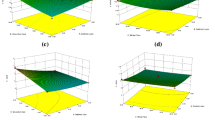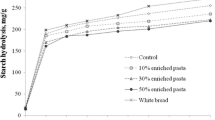Abstract
The present study was carried out to optimize the level of groundnut meal, capsicum juice and refined wheat flour for the development of pasta with enhanced protein and antioxidant activity using response surface methodology. Box–Behnken design of experiments was used for designing different experimental combinations considering groundnut meal from 10 to 20 g, capsicum juice from 14 to 30 mL and refined wheat flour from 80 to 90 g, respectively. Antioxidant activity and phenolics content were increased with increasing level of groundnut meal and capsicum juice in the samples. Pasta samples having higher level of groundnut meal showed higher protein contents. Conversely, the pasta samples with higher capsicum juice showed high rehydration ratio with low solid loss. The colour and cooking quality of pasta samples was also affected with different levels of groundnut meal, capsicum juice and refined wheat flour. Optimization was done to obtain the best experimental combination for development of groundnut meal and capsicum juice for developing pasta with enhanced protein and antioxidant activity. Optimized groundnut meal and capsicum fortified pasta consisted of 20 g groundnut meal, 30 mL capsicum juice and about 89.99 g refined wheat flour. The total protein content, phenolics content and antioxidant activity in pasta with optimized formulation were 17.81 %, 342.27 mg/100 g and 18.12 %, respectively with overall sensory acceptability as 8.73. This pasta sample showed 4.71 min cooking time, 2.57 rehydration ratio and 2.42 % solid loss with overall desirability of 0.879.





Similar content being viewed by others
References
Abdel-Aal ESM, Hucl P (2002) Amino acid composition and in vitro protein digestibility of selected ancient wheats and their end products. J Food Compost Anal 15(6):737–747
AOAC (2000) Official methods of analysis, 17th edn. The Association of Official Analytical Chemists, Washington
Bas D, Boyaci IH (2007) Modeling and optimization I, usability of response surface methodology. J Food Eng 78:836–845
Basha SM, Pancholy SK (1982) Composition and characteristics of basic proteins from peanut (Arachis hypogaea L.). J Agric Food Chem 30:1176–1179
Brennan CS, Kuri V, Tudorica CM (2003) Inulin-enriched pasta: effects on textural properties and starch degradation. Food Chem 86(2):189–193
Bruneel C, Pareyt B, Brijs K, Delcour JA (2010) The impact of the protein network on the pasting and cooking properties of dry pasta products. Food Chem 120:371–378
Carbonaro M, Mattera M, Nicoli S, Bergamo P, Cappelloni M (2002) Modulation of antioxidant compounds in organic vs conventional fruit (peach, Prunus persica L., and pear, Pyrus communis L.). J Agric Food Chem 50:5458–5462
Chillo S, Laverse J, Falcone PM, Protopapa A, Del Nobile MA (2008) Influence of the addition of buckwheat flour and durum wheat bran on spaghetti quality. J Cereal Sci 47(2):144–152
Desai BB, Kotecha PM, Salunkhe DK (1999) Composition and nutritional quality. Introduction science and technology of groundnut: biology, production, processing and utilization. Naya Prokash Publisher, New Delhi, pp 185–199
Dick JW, Youngs VL (1988) Evaluation of durum wheat semolina and pasta in the United States. In: Fabriani G, Lintas C (eds) Durum Wheat: Chemistry and Technology. American Association of Cereal Chemists, St. Paul, pp 237–248
Durucasu I, Tokusoglu O (2007) Effect of grilling on luteolin (3′,4′,5,7 tetrahydroxyflavone) content in sweet green bell pepper (Capsicum annum). Pak J Biol Sci 10(19):3410–3414
Eberhardt MV, Lee CY, Liu RH (2000) Antioxidant activity of fresh apples. Nature 405:903–904
Floridi S, Montanari L, Ombretta M, Fantozzi P (2003) Determination of free phenolic acids in wort and beer by colorimetric array detection. J Agric Food Chem 51:1548–1554
Galvez FCF, Resurreccion AVA (1992) Reliability of the focus group technique in determining the quality characteristics of mung bean noodles. J Sens Stud 7:315
Gey KF (1990) The antioxidant hypothesis of cardiovascular disease: epidemiology and mechanisms. Biochem Soc Trans 18:1041–1045
Gomes LMM, Petito N, Costa VG, Falcao DQ, Araujo KGL (2014) Inclusion complexes of red bell pepper pigments with b-cyclodextrin: preparation, characterisation and application as natural colorant in Yogurt. Food Chem 148:428–436
Gopala Krishna AG (2007) Edible oilseed, oil and meal need for quality control. Beverage Food World 34(1):42–44
Howard LR, Smith RT, Wagner AB, Villalon B, Burns EE (1994) Provitamin A and ascorbic acid content of fresh pepper cultivars (Capsicum annuum) and processed jalapenos. J Food Sci 59:362–365
Howard LR, Talacott ST, Brenes CH, Villalon B (2000) Changes in phytochemical and antioxidant activity of selected pepper cultivars (Capsicum species) as influenced by maturity. J Agric Food Chem 48:1713–1720
Hundal M, Bakshi AK, Sexena AK (2006) Effect of various kinds of flour (soy, rice and wheat) substitutions on the quality characteristics of spaghetti made from wheat semolina. Beverage Food World 33(8):74–76
Jadczak D, Grzeszczuk M, Kosecka D (2010) Quality characteristics and content of mineral compounds in fruit of some cultivars of sweet pepper (Capsicum annuum L.). J Elementol 15(3):509–515
Khan MN, Lawhon JT (1980) Baking properties of oilseed protein and isolates produced with industrial membrane systems. Cereal Chem 57:433–436
Khan MN, Rhee KC, Rooney LW, Cater CM (1975) Bread making properties of aqueous processed peanut protein concentrates. J Food Sci 40:580
Kim SY, Wiesenborn DP, Orr PH, Grant LA (1995) Screening potato starch for novel properties using differential scanning calorimetry. J Food Sci 60:1060–1065
Kouassi KC, Koffi-Nevry R, Guillaume LY, Yesse ZN, Koussemon M, Kablan T, Athanase KK (2012) Profiles of bioactive compounds of some pepper fruit (Capsicum L.) varieties grown in Cote Divoire. Innovat Rom Food Biotechnol 11:23–31
Lawless HT, Heymann H (1998) Sensory evaluation of foods, principles and practices. Springer, New York
Li H-B, Cheng K-W, Wong C-C, Fan K-W, Chen F, Jiang Y (2007) Evaluation of antioxidant capacity and total phenolic content of different fractions of selected microalgae. Food Chem 102:771–776
Liyana-Pathirana C, Shahidi F (2005) Optimization of extraction of phenolic compounds from wheat using surface response methodology. Food Chem 93:47–56
Mahadu L, Ranganna R (2010) Modified atmospheric packaging to enhance the shelf life of capsicum fruits. Mysore J Agric Sci 44(2):417–420
Monge L, Cortassa G, Fiocchi F, Mussino G, Carta Q (1990) Glycoinsulinaemic response, digestion and intestinal absorption of the starch contained in two types of spaghetti. Diabetes Nutr Metab 3:239–246
Mridula D, Gupta RK, Khaira H, Bhadwal S (2015) Groundnut Meal and carrot fortified pasta: optimization of ingredients level using RSM. Proc Natl Acad Sci India Sect B Biol Sci. doi:10.1007/s40011-015-0586-x
Mridula D, Gupta RK, Bhadwal S, Khaira H, Tyagi SK (2016) Optimization of food materials for development of nutritious pasta utilizing groundnut meal and beetroot. J Food Sci Technol. doi:10.1007/s13197-015-2067-x
Mujica-Paz H, Valdez-Fragoso A, Lopez-Malo A, Palou E, Welti-Chanes J (2003) Impregnation and osmotic dehydration of some fruits: effect of the vacuum pressure and syrup concentration. J Food Eng 57(4):305–314
Nakamura Y, Watanabe S, Miyake N, Kohno H, Osawa T (2003) Dihydrochalcones: evaluation as novel radical scavenging antioxidants. J Agric Food Chem 51:3309–3312
Scherer R, Godoy HT (2009) Antioxidant activity index (AAI) by the 2,2-diphenyl-1-picrylhydrazyl method. Food Chem 112:654–658
Scherer R, Godoy HT (2014) Effects of extraction methods of phenolic compounds from Xanthium strumarium L. and their antioxidant activity. Rev Bras Plantas Med 16(1):41–46
Shenoy SF, Kazaks AG, Holt RR, Chen HJ, Winters BL, Khoo CS (2010) The use of a commercial vegetable juice as a practical means to increase vegetable intake: a randomized controlled trial. Nutr J 9:38–49
Shotorbani N, Jamei R, Heidari R (2013) Antioxidant activities of two sweet pepper Capsicum annuum L. varieties phenolics extracts and the effects of thermal treatment. Avicenna J Phytomed 3:25–34
Shyu SL, Hwang LS (2001) Effect of processing conditions on the quality of vacuum fried apple chips. Food Res Int 34(2):133–142
Singh S, Raina CS, Bawa AS, Saxena DC (2004) Sweet potato based pasta product: optimization of ingredient levels using RSM. Int J Food Sci Technol 39:191–200
Singleton VL, Rossi JA (1965) Colorimetry of total phenolics with phosphomolybdic phosphotungstic acid reagents. Am J Enol Viticult 16:144–158
Tapiero H, Tew KD, Ba GN, Mathe G (2002) Polyphenol: do they play a role in the prevention of human pathologies. Biomed Pharmacother 56:200–207
USDA-NAL (2005) United States Department of Agricultural-National Agricultural Library. USDA Nutrient Database for Standard Reference, Release 18. http://www.nal.usda.gov/fnic/foodcomp/cgi-bin/list_nut_edit.pl
Vengaiah PC, Pandey JP (2007) Dehydration kinetics of bell pepper (Capsicum annum L.). J Food Eng 81:282–286
Venkataraghavan U (1998) Newer dimensions in the processing of oil seeds for food uses. Indian Food Ind 17:272–275
Willett WC (1991) Micronutrients and cancer risk. Am J Clin Nutr 53:265S–269S
Yadav DN, Thakur N, Sunooj KV (2012) Effect of partially de-oiled peanut meal flour (DPMF) on the nutritional, textural, organoleptic and physico chemical properties of biscuits. Food Nutr Sci 3(4):471–476
Zhao G, Liu Y, Zhao M, Ren J, Yang B (2011) Enzymatic hydrolysis and their effects on conformational and functional properties of peanut protein isolate. Food Chem 127(4):1438–1443
Author information
Authors and Affiliations
Corresponding author
Rights and permissions
About this article
Cite this article
D., M., Gupta, R.K., Bhadwal, S. et al. Optimization of Groundnut Meal and Capsicum Juice for Protein and Antioxidant Rich Pasta. Agric Res 5, 293–304 (2016). https://doi.org/10.1007/s40003-016-0216-8
Received:
Accepted:
Published:
Issue Date:
DOI: https://doi.org/10.1007/s40003-016-0216-8




